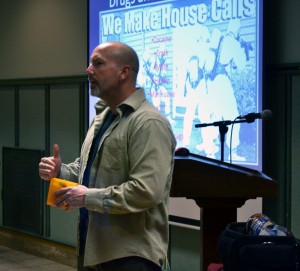Forum held to combat youth drug abuse
By Bobby-Jo Keats

Windsor Police Constable Todd Pearce holds a sample from his drug kit to show guests during a presentation at the Giovanni Caboto Club March 20.
Associate Managing Editor
New Beginnings is teaming up with law enforcement to educate parents about drug abuse among young people.
Parents were provided with information regarding the warning signs of drug use, prevention strategies and intervention strategies at the Giovanni Caboto Club on March 20. There were 65 people in attendance and the event was organized by New Beginnings, a multi-service organization that provides services to children and youth up to 18-years-old. Lead Substance Abuse Counsellor Jennifer Forfitt hosted the event and highlighted the importance of parents being informed and talking to their children about substance abuse.
Windsor Police Constable Todd Pearce, who has previously worked on the drug squad, gave a presentation about drug abuse and also answered questions from parents. Pearce has given presentations at the University of Windsor and St. Clair College. He said he always brings a drug kit with him to show parents what common drugs look like and how to detect if their child is using them.
“Youth substance abuse is very prevalent in our community and prevention starts within the home,” said Forfitt. “Research shows that one in six students in Grade 9 to 12 throughout Ontario show symptoms of drug abuse. So it’s very important for parents to gain any additional information they can and go home and share that information with their children.”
The forum provided parents with information such as local statistics of alcohol and drug use by students from Grades 7 – 12. There was also information available about coping strategies, lists and images of common drugs and counsellors to talk to about how to appropriately handle confronting their child about drug use.
“I’m here today to educate the general public, parents and anyone who works in social work,” said Pearce. “New Beginnings is discussing substance abuse and I am here to discuss what we see in the policing world. How kids hide their drugs, how they are sold, how they are packaged and I have samples to show people as well. Thankfully, New Beginnings did this. It’s great.”
Forfitt said it is important parents keep an eye out for warning signs that their child may be abusing drugs. She said symptoms might include slipping grades, lower attendance at school, dropping out of their favorite sporting events, not answering questions about drugs or even altering their appearance to cover-up evidence of drug use. According to Forfitt, this could include wearing long sleeves to cover track marks, the scent of drugs on their clothing or wearing sunglasses more frequently to hide evidence of drug use in their eyes.
“It’s important to have a law enforcement aspect as well as a counselling aspect of this problem,” said Forfitt. “It helps parents gain information about prevention strategies, intervention strategies and where to go for additional support if needed. We want parents to see the major drugs that many youths are struggling with.”
The Ontario Student Drug Use and Health Survey is a detailed drug use report based on self reports derived from anonymous questionnaires administered to classrooms between November 2012 and June 2013. It is a survey of 10, 272 students and is the longest ongoing school survey of adolescents in Canada. According to a recent -OSDUHS report, 49 per cent of students in Grades 7 – 12 admit to drinking alcohol, 19 per cent of which admit to binge drinking. In the same poll, 23 per cent of students admit to using marijuana. When students from Grades 9 – 12 were surveyed, 15 per cent of them admitted to the non-medical use of prescription drugs.
Also discussed at the event was the topic of alcohol abuse by youths, often as a result of accessibility. Drugs such as cocaine, crack, Ecstasy, heroin, inhalants, marijuana and methamphetamines were discussed. The abuse of cough medicine, prescription pain relievers, sedatives, tranquilizers, prescription stimulants, steroids and tobacco were also discussed.
Courtney Primeau, 28, is a fourth year student at the University of Windsor is currently doing her placement at the Well-Centre, a shelter for women. Primeau said she has worked with many women who suffer from substance abuse problems and just wants to help.
“I’m here today to learn how I can better help people. I just hope I gain a better understanding of how to best serve the women at the shelter and learn new techniques that will aid me throughout my career,” said Primeau.
Pearce showed the differences in appearance of the drug ecstasy as well as the long-term damage it causes the nervous system. By means of the drug kit, parents were able to see a visual representation of drugs common among local youth.
“It’s not always an easy topic to talk about, and sometimes you need to be non-judgmental and calm when approaching youth,” said Forfitt. “So they must be handled with care. Hopefully parents can learn new strategies and techniques here to utilize within their own homes with youths that may be struggling with drugs or alcohol.”
In order to combat youth drug abuse, knowledge is power.


